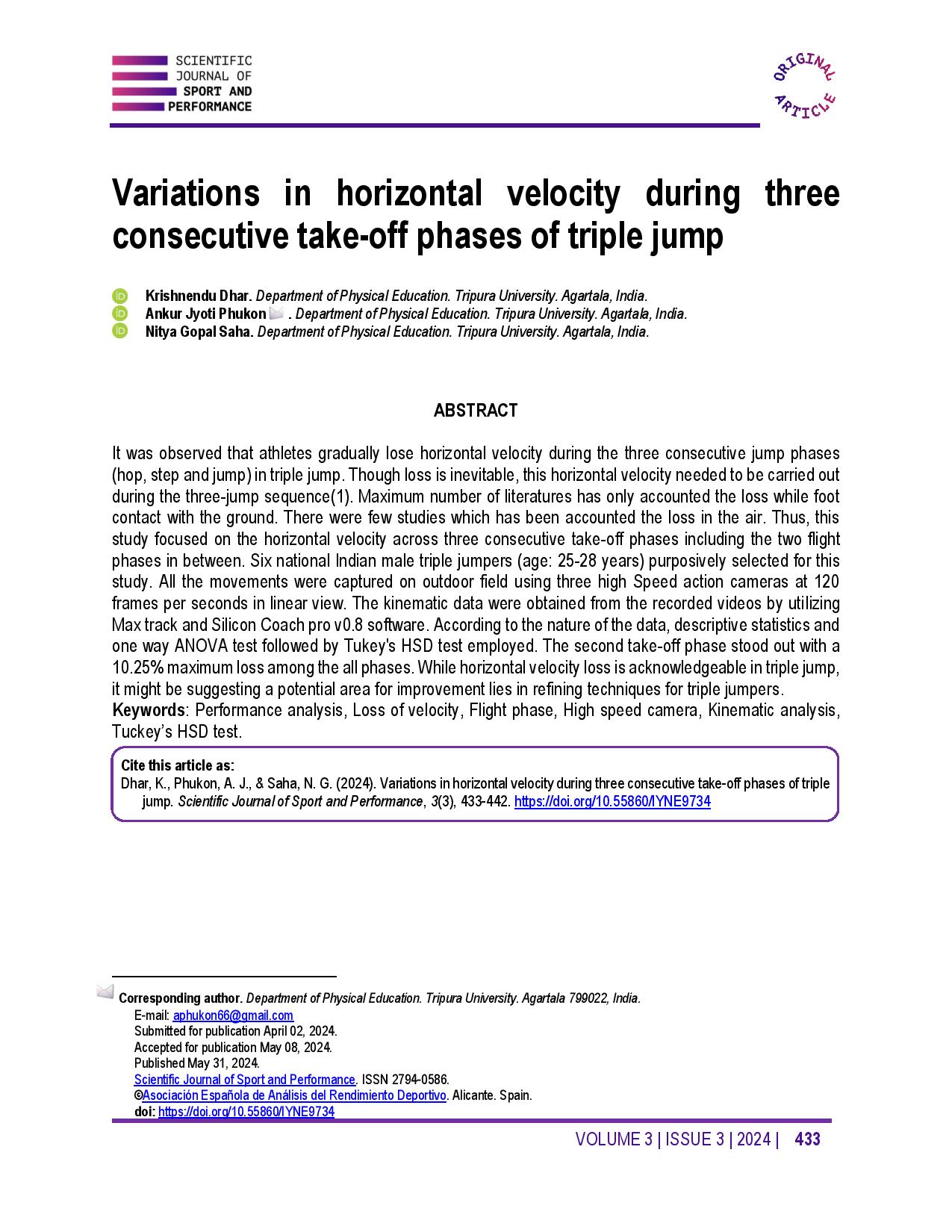Variations in horizontal velocity during three consecutive take-off phases of triple jump
Main Article Content
Abstract
It was observed that athletes gradually lose horizontal velocity during the three consecutive jump phases (hop, step and jump) in triple jump. Though loss is inevitable, this horizontal velocity needed to be carried out during the three-jump sequence(1). Maximum number of literatures has only accounted the loss while foot contact with the ground. There were few studies which has been accounted the loss in the air. Thus, this study focused on the horizontal velocity across three consecutive take-off phases including the two flight phases in between. Six national Indian male triple jumpers (age: 25-28 years) purposively selected for this study. All the movements were captured on outdoor field using three high Speed action cameras at 120 frames per seconds in linear view. The kinematic data were obtained from the recorded videos by utilizing Max track and Silicon Coach pro v0.8 software. According to the nature of the data, descriptive statistics and one way ANOVA test followed by Tukey's HSD test employed. The second take-off phase stood out with a 10.25% maximum loss among the all phases. While horizontal velocity loss is acknowledgeable in triple jump, it might be suggesting a potential area for improvement lies in refining techniques for triple jumpers.
Article Details

This work is licensed under a Creative Commons Attribution-NonCommercial-ShareAlike 4.0 International License.
References
Allen, S. J., King, M. A., & Yeadon, M. R. (2013). Trade-offs between horizontal and vertical velocities during triple jumping and the effect on phase distances. Journal of Biomechanics, 46(5), 979-983. https://doi.org/10.1016/j.jbiomech.2012.12.011 DOI: https://doi.org/10.1016/j.jbiomech.2012.12.011
Campos, J., Gàmez, J., Encarnación, A., Gutiérrez-Dávila, M., Rojas, J., & Wallace, E. S. (2013). Three-Dimensional Kinematics during the Take-Off Phase in Competitive Long Jumping. International Journal of Sports Science & Coaching, 8(2), 395-406. https://doi.org/10.1260/1747-9541.8.2.395 DOI: https://doi.org/10.1260/1747-9541.8.2.395
Ding, Y. (2003). The Kinematic Analysis on Loss of Horizontal Velocity for Our Elite Male Triple Jumpers. Sport Science and Technology.
Eissa, A. (2014). Biomechanical Evaluation of the Phases of the Triple Jump Take-Off in a Top Female Athlete. Journal of Human Kinetics, 40(1), 29-35. https://doi.org/10.2478/hukin-2014-0004 DOI: https://doi.org/10.2478/hukin-2014-0004
Fukashiro, S., Timoto, Y., Kobayashi, H., & Miyashita, M. (1981). A biomechanical study of the triple jump. Medicine & Science in Sports & Exercise, 13(4), 233. https://doi.org/10.1249/00005768-198104000-00005 DOI: https://doi.org/10.1249/00005768-198104000-00005
Hay, J. G. (1992). The biomechanics of the triple jump: A review. Journal of Sports Sciences, 10(4), 343-378. https://doi.org/10.1080/02640419208729933 DOI: https://doi.org/10.1080/02640419208729933
He, Z., Ye, B., Zhang, Z., Gao, F., & Zhu, H. (2023). A Kinematic Study of Technical Characteristics in Elite Male Triple Jump Athletes in Zhejiang Province. Open Access Library Journal, 10(10), Article 10. https://doi.org/10.4236/oalib.1110754 DOI: https://doi.org/10.4236/oalib.1110754
Isik, B. (2017). Relationships between horizontal velocity variables and jump performance in the triple jump. 2.
Jia, Yi. (2006). Kinematic Analysis of Triple Jump Technique of Elite Male Triple Jumpers in China. Sport Science and Technology.
Linthorne, N.P. (2006). Throwing and jumping for maximum horizontal range. arXiv: Physics Education.
Liu, H., Mao, D., & Yu, B. (2015). Effect of approach run velocity on the optimal performance of the triple jump. Journal of Sport and Health Science, 4(4), 347-352. https://doi.org/10.1016/j.jshs.2015.07.001 DOI: https://doi.org/10.1016/j.jshs.2015.07.001
Liu, P. H., Zhang, Y. B., & Liang, X. D. (2013). Biomechanical Study on Take-Off Technique of Junior Male Long Jumpers. Advanced Materials Research, 791-793, 1301-1304. https://doi.org/10.4028/www.scientific.net/AMR.791-793.1301 DOI: https://doi.org/10.4028/www.scientific.net/AMR.791-793.1301
Lu, G., & Wang, Z. (2005). Biomechanical analysis on take-off technique of chinese and world-class triple-jumpers.
Mehta, V.K., & Mehta, R. (2013). Principle of Physics (7th ed.). S. Chand.
Miller, J. A., & Hay, J. G. (1986). Kinematics of a World Record and Other World-Class Performances in the Triple Jump. International Journal of Sport Biomechanics, 2(4), 272-288. https://doi.org/10.1123/ijsb.2.4.272 DOI: https://doi.org/10.1123/ijsb.2.4.272
Panoutsakopoulos, V., & Kollias, I. A. (n.d.). Female triple jump technique. 4.
Sang-Yeon Woo, Jung suk seo, ho mook kim, yong woon kim, Sung-Bum Choi, & Ki-Jeong Nam. (2011). Kinematic Analysis of Men's Tr iple Jump at IAAF Wor ld Championships, Daegu 2011. Korean Journal of Sport Biomechanics.
Tsukuno, A., Ae, M., Koyama, H., Muraki, Y., & Takamoto, M. (2011). Analysis of the takeoff motion for the world top female triple jumpers. ISBS - Conference Proceedings Archive. Retrieved from [Accessed 2024, May 15]: https://ojs.ub.uni-konstanz.de/cpa/article/view/4859
Tucker, C., Nicholson, G., Cooke, M., & Bissas, A. (2018). Men's triple jump-2017 IAAF World Championships. Leeds Beckett University.
Yu, B. (1999). Horizontal-to-vertical velocity conversion in the triple jump. Journal of Sports Sciences, 17(3), 221-229. https://doi.org/10.1080/026404199366127 DOI: https://doi.org/10.1080/026404199366127




